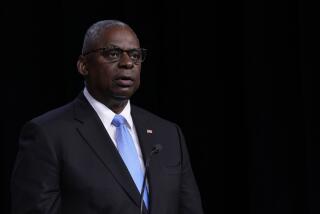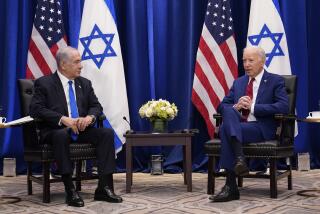U.S. Gives No Clue to Timing of First Strike
- Share via
WASHINGTON — War has been declared. The world has been told to choose sides. So now the countdown begins.
Yet President Bush’s thundering pledge Thursday night that “the hour is coming when America will act” offered not a single solid clue about just when that hour will be.
Is the first strike just days away, as the Washington rumor mill has hyped it? Or is the United States in for a methodical Gulf War-type buildup of weeks or months to prepare for a major offensive?
Both possibilities have their strengths and vulnerabilities, according to military and policy analysts.
“If we intend to do some real disruption to the Al Qaeda organization or even try to pick up Osama bin Laden, we’ll need a lot of planning and preparation. On the other hand, the element of short-term surprise can be important,” said Stephen Flanagan, director of the Institute for National Strategic Studies at the National Defense University in Washington.
The calculations range from mundane but crucial factors such as the weather--the frigid winter snows usually freeze Afghanistan’s civil war in place until the spring--to religious considerations such as Ramadan, the Islamic month of fasting. Both begin in mid-November.
But the biggest issue in deciding when to attack is the military objective, analysts say. And that remains unclear.
Bush stressed Thursday that Afghanistan’s ruling Taliban would be punished if it did not turn over suspected terrorist Bin Laden. But the question he didn’t answer was whether the United States actually intends to oust the Afghan government--an issue the White House again refused to address Friday. The answer is important in determining when and how the first strike will take place.
“If you want to dislodge the regime in Kabul, you need an overwhelming ground force, which requires a good bit of time for deployment. If you want to punish them, then you can use a smaller package of Special Forces and air power more quickly put in place,” said James Steinberg, deputy national security advisor during the Clinton administration, now at the nonpartisan, centrist Brookings Institution in Washington.
So far, with the deployment of dozens of military aircraft and untold special operations units, the deployment appears limited by comparison to the 1991 Persian Gulf War, when half a million foreign troops fought in the U.S.-led coalition. That may indicate the mission has narrower goals, analysts say.
“The emphasis is on Special Forces and long-term bombing--with no apparent interest in repeating the Russian model,” said Anthony Cordesman, a military strategist at the Center for Strategic and International Studies in Washington, referring to the 1979-89 Soviet occupation of Afghanistan.
Politics May Not Wait Out Winter
The weather, meanwhile, argues for quick action--and so do domestic and international politics.
“In the winter, it’ll be very difficult to put Special Forces on the ground and operate, so the preference would be to get as much as possible done before then,” said Kenneth M. Pollack, a National Security Council staff member in the Clinton and George Bush administrations and now at the nonprofit Council on Foreign Relations in Washington.
“The smart thing to do is wait until spring when you’d have tons of intelligence, forces set in place and ready to go, and eight months of uninterrupted good weather to run an operation. But it’s unclear whether domestic and international politics would sustain such a long wait.”
By spring, the United States also could provide the Northern Alliance, the Afghan opposition force, with new supplies and training, radios for direct communication and time to let a new commander prepare. The alliance’s charismatic guerrilla leader was assassinated in a suicide bombing the weekend before the Sept. 11 attacks in New York and Arlington, Va.--a bombing allegedly carried out by Bin Laden agents.
Another immediate consideration may be the president’s scheduled Asian trip, now just three weeks away. Bush must decide whether he wants to use his meeting with 21 Asian leaders to rally more international support for a war in their backyard, or whether domestic expectations are now so primed that he can’t hold off until he returns.
The U.S. economy may prove a factor. One of the dozens of scenarios flying around Washington says the first strike has to be soon because of the rapidly sinking economy.
“Until people have some sense of how long this is going to last--because things get frozen, because people are glued to their televisions, not out buying refrigerators--there is an uncertainty which freezes buying and building,” said former National Security Advisor Samuel R. “Sandy” Berger.
But other analysts insist that military considerations trump all else. “Who cares if it’s Ramadan? We need to be careful not to piggyback secondary issues onto broader military objectives. With the complexity of the target, the key issue is when there are windows of opportunity for a coherent strike plan that will have limited collateral damage,” Cordesman said.
Intelligence Will Dictate in the End
Once the bigger objective is determined, the precise day of attack will be driven almost entirely by intelligence that pinpoints where Bin Laden and his fighters are, according to retired Marine Gen. Anthony C. Zinni, a former commander of U.S. forces in the Mideast.
He said that with an enemy like Bin Laden, who is known to move quickly from hiding place to hiding place, Pentagon planners will focus on positioning U.S. forces within striking distance of where Bin Laden is believed to be at a particular moment.
“With this type of enemy, what is most important is accurate intelligence, and it is fleeting,” Zinni said. Above all, he added, “You don’t want failed [operations] that miss the target. You want to minimize risk. All that is driven by intelligence.”
*
Times staff writer Esther Schrader contributed to this report.
*
RELATED STORY
Senate truce: Democrats agree to more funding for missile defense or anti-terrorism programs. A16
More to Read
Get the L.A. Times Politics newsletter
Deeply reported insights into legislation, politics and policy from Sacramento, Washington and beyond. In your inbox three times per week.
You may occasionally receive promotional content from the Los Angeles Times.










